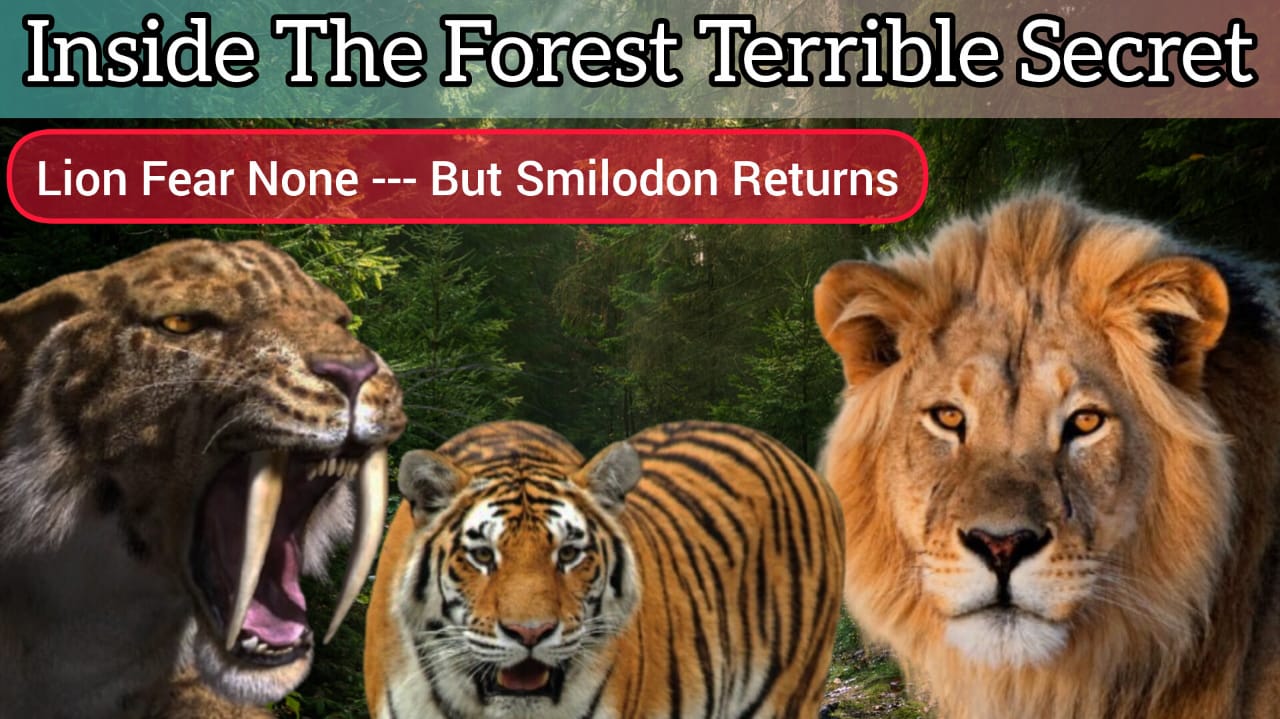Lion, Tiger, and Smilodon. Three legendary predators that once ruled the wild, from the dense jungles of Asia to the frozen plains of the Ice Age. Each of these mighty cats tells a different story of evolution: the lion, master of teamwork and pride; the tiger, a silent and powerful hunter; and the smilodon, the prehistoric beast defined by brute strength and saber-like fangs.
But among these fierce hunters, who was truly the most powerful and dangerous predator in history? Let’s dive into their world and uncover the hidden truths of nature’s greatest warriors.
1.The Lion King of the Savannah 🦁
Scientific name: Panthera leo
Habitat: African grasslands and Indian forests
Lions are known as social predators, living in groups called prides — usually one male, several females, and their cubs. This makes them unique among big cats, who generally prefer solitary lives.
Power and Danger Level
Bite Force: ~650 PSI (pounds per square inch)
Speed: Up to 80 km/h (50 mph)
Strength: Exceptional teamwork allows them to hunt larger prey, like buffalo or giraffes. “The lion’s true power lies not in its fangs but in its pride.”
Evolutionary Note
Lions evolved around 1.5 million years ago, adapting perfectly to open habitats. Their social structure increased their hunting efficiency, making them one of the top apex predators even today.
2.The Tiger Silent Power of the Jungle 🐅
Scientific name: Panthera tigris
Habitat: Dense forests and grasslands of Asia
Tigers are solitary hunters, relying on stealth and ambush rather than speed. Their muscular build and razor-sharp instincts make them one of the strongest predators on Earth.
Power and Danger Level
Bite Force: ~1,000 PSI
Speed: 65 km/h (40 mph)
Strength: A single tiger can take down prey twice its weight.
Unique Traits
Tigers are excellent swimmers, unlike most cats.
They have distinctive stripe patterns — no two tigers are alike. “Where the lion rules by pride, the tiger conquers with silence.”
3.The Smilodon Prehistoric Saber-Toothed Legend 🐾
Scientific name: Smilodon fatalis
Habitat: Ice Age Americas (grasslands, woodlands, and open plains)
Smilodon, often miscalled a “saber-toothed tiger,” was neither a tiger nor a lion but a unique species that vanished about 10,000 years ago.
Power and Danger Level
Bite Force: Surprisingly low (~600 PSI), but deadly with its 20 cm (8-inch) saber teeth.
Strength: Exceptionally muscular forelimbs for wrestling and pinning prey.
Speed: Moderate — it relied on ambush rather than chase.
Evolutionary Note
Smilodons hunted large Ice Age herbivores like mammoths and bison. They were ambush predators, using their strong arms to immobilize prey before delivering a fatal throat bite.
Where Does It All Take Place?🌍
Lions: Africa and small parts of India.
Tigers: Asia (India, Russia, Indonesia, etc.).
Smilodon: Prehistoric Americas (North & South).
Though separated by continents and time, these apex cats share a powerful evolutionary lineage under the Pantherinae subfamily.
How Many Are There in record Today?
Lions: Around 20,000 remain in the wild.
Tigers: Fewer than 4,000 survive — critically endangered.
Smilodon: Extinct for over 10,000 years.
Conservationists are working tirelessly to ensure lions and tigers don’t share Smilodon’s fate.
Who Is the Most Powerful and Dangerous?⚔️
| Animal | Bite Force | Hunting Style | Strength | Verdict |
|---|---|---|---|---|
| Lion | 650 PSI | Team (Pride) | High (Group Power) | Tactical King |
| Tiger | 1,000 PSI | Solitary | Massive (Muscular Build) | Strongest Modern Cat |
| Smilodon | 600 PSI | Ambush | Brutal Forelimbs | Ice Age Assassin |
Verdict: ✅
Most Powerful: Tiger (strongest bite, incredible solo strength)
Most Dangerous (Historically): Smilodon (prehistoric brute power and saber-teeth)
Most Dominant Today: Lion (social intelligence and teamwork)
Key Takeaways 💡
Lions thrive in social groups called prides, making them strategic hunters.
Tigers are the strongest solo predators alive today.
Smilodon, though extinct, was a muscular ambush hunter from the Ice Age.
All three showcase evolution’s creativity in shaping the world’s top predators.
For an in-depth exploration of big cats and their survival instincts, visit:
👉 National Geographic – Big Cats: Ultimate Predators
Just as these big cats shaped the wild in their own eras, the UAE’s modern conservation projects continue that legacy — learn more in our post on 🌱 Plant the UAE Initiative.
Frequently Asked Questions ❓
Q1: Could a tiger defeat a lion in a one-on-one battle?
A tiger is generally larger and stronger, giving it an edge — but lions’ endurance and group tactics are unmatched.
Q2: How big was the Smilodon compared to a modern lion or tiger?
Smilodon was shorter but twice as muscular, weighing up to 400 kg (880 lbs).
Q3: Why did the Smilodon go extinct?
Most likely due to climate change and loss of large prey after the Ice Age.
Q4: Are lions and tigers related to the Smilodon?
They share a distant evolutionary ancestor, but Smilodon belongs to a separate extinct branch.
Conclusion 🧭
The lion, tiger, and smilodon each represent a different chapter of nature’s story — social strength, solitary dominance, and prehistoric power.
While the tiger may claim the title of the strongest living predator, the lion remains the symbolic king, and the smilodon stands as a legend of lost ferocity.
“In the wild, survival is not just about power — it’s about evolution, adaptation, and legacy.”
